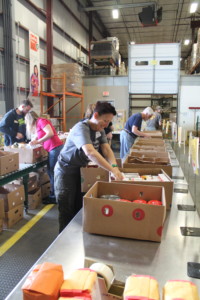The Vermont Foodbank has taken a leadership role in supporting the implementation of Vermont’s Universal Recycling Law and its efforts of diverting waste, including food fit for human consumption, from Vermont’s landfills by July 1, 2020. As part of our work in support of this law, the Foodbank is taking a deep dive into our own waste generation activities so we can better understand what waste is unpreventable as a byproduct of our donation model and what waste is preventable via improved supply chain and distribution activities.
 To understand how the Foodbank generates waste you must first understand how the Foodbank acquires the 10 million pounds of food we distribute each year. In FY15:
To understand how the Foodbank generates waste you must first understand how the Foodbank acquires the 10 million pounds of food we distribute each year. In FY15:
- 59% of food acquired was donated or rescued. These products are frequently at end of life and require sorting by staff and/or volunteers to ensure that only high-quality food is being distributed to Network Partners and clients. This category includes both produce and raw grocery salvage which can vary greatly in quality at the point of acquisition.
- 14% of food was purchased for our COOP program and various other grant-funded programs. This is retail, first-quality product.
- 27% of food was provided via Federal government programs like TEFAP and CSFP. This is retail, first-quality product.
As a general rule, unpreventable food waste is generated from donated or rescued sources while preventable food waste will primarily fall under purchased or Federal product. This doesn’t always hold true since there are so many variables in our warehousing and distribution environments, but it’s a good starting point for understanding sources of waste nonetheless.
So how did the Foodbank do mitigating waste in the last twelve months? We accomplished a 1.55% waste rate which represents about 155,000 pounds of product discarded out of roughly 10 million pounds of product acquired. This was a 17% decrease in waste when compared with 2014’s performance. Of that 1.55% less than 50% was “preventable” waste. The majority of the “preventable” waste was short-coded product that we were unable to distribute in time and produce that deteriorated faster than expected.
 The year-over-year improvement was driven by two main factors: faster produce handling and a focus on donor education to ensure donation of quality product.
The year-over-year improvement was driven by two main factors: faster produce handling and a focus on donor education to ensure donation of quality product.
The Foodbank distributed a record 1.7 million pounds of produce in fiscal year 2015. With this significant increase in produce distribution we would have expected to see a corresponding increase in preventable waste but this was avoided by decreasing the holding time of perishable product from an average of three days to only 1.5 days. As we continue to review and revise our delivery routes we should continue to see an increase in direct farm to network partner produce distribution and a corresponding decrease in perishable product holding times, which will contribute to additional decreases in “preventable” waste.
Targeted donor education is integral to ensuring that the Foodbank receives high-quality product from our retail and producer partners. The Foodbank has staff dedicated to working with donors on safe handling of donated product and acceptable quality levels of donated product. The more we can ensure quality product is coming in to our facilities the more efficient we can be in sorting and distributing that product, resulting in less “unpreventable” waste.
The Foodbank is dedicated to making further strides in our waste reduction in the coming twelve months. Our goal is to reduce our overall waste to under 1% of incoming product and to reduce our “preventable” waste to under 35% of overall waste. We’re confident that we’ll attain these goals by continuing to improve our warehousing and logistics processes and by working closely with donors to ensure only high-quality product is being donated to our facilities.
